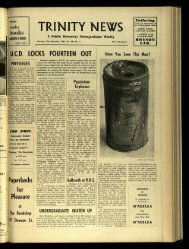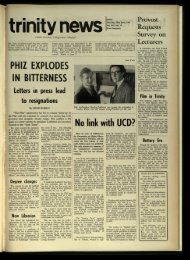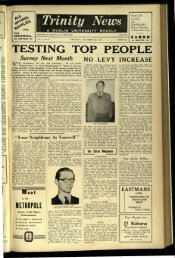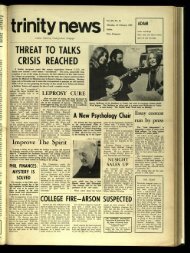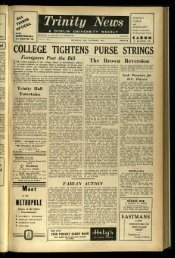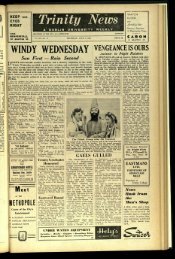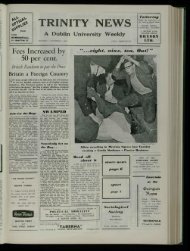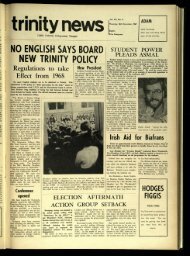MacBRIDE SPEAKS - Trinity News Archive
MacBRIDE SPEAKS - Trinity News Archive
MacBRIDE SPEAKS - Trinity News Archive
Create successful ePaper yourself
Turn your PDF publications into a flip-book with our unique Google optimized e-Paper software.
~26, 1959TRINITY NEWSTHE NATIONAL LIBRARYOF IRt LANDTHOMAS P. O’NEILL, M.A., F.L.A.I., Assistant Keeper of Printed BooksThe National Library of Ireland owesits origin, as do many of our nationali~stitutions, such as the Museum, Collegeof Art and Botanical Gardens, to thel~0yal Dublin Society. When that body~s founded in 1731, one of its firstducisions was to establish a library. In1877 that library was handed over to theState and became the nucleus of theNational Library of Ireland. Since itbecame the National Library it hasbeen the policy of successive librariansto collect every book relating to Ireland,printed in Ireland or written by an Irishsan.Also it has been part of the policyfollowed in the selection of books topurchase a representative collection ofe b~st books on every subject. Inpursuing this policy, the library has beenassisted, since 1927, by the operation ofa copyright law ua~der which a copy ofevery item published in the State has tobe presented. Also by the fact of theState’s membership of international0rganisations, the library has become adeposit library for the publications ofsuch bodies as U.N.O., U.N.E.S.C.O.,FA.0. Among its collections is a set ofthe League of Nations’ publications.Also the official documents, reports andother Works of the British Governmentand a great number of those of theUnited States are taken by the library,which also takes some seven hundredperiodicals and newspapers. The newspapercollection is extremely valuablefor the eighteenth and nineteenthcenturies.The department of manuscripts hasdeveloped and expanded greatly in rece.ntdecades. It contains about 10,000volumes of bound manuscriuts (includ-~g nearly 1,000 in Irish) and a largequantity of deeds and unbound items.The Ormond papers from Kilkerm~Castle are of particular importance for~venteenth century history, and theWilliam Smith O’Brien papers are valuablefor the nineteenth. Papers of LordLieutenants, such as the Duke of Richm0nd,stand shoulder to shoulder withthose of patriots such as James FintanLalor and Lord Edward Fitzgerald. Theearly amvels in the handwriting ofGeorge Beraaard Shaw and the manu-~ripts of "The Portrait of the Artist"This"Common Sense and Nuclear Warfare."By Bertrand Russell. 3/6 from anybookshop.This book should be read by anyonewho wants to stay alive, which pre-~nably means you.Your life is threatened; what are youd0ing about it ?¯ This may seem an extreme statement,~.t it is provable. Bertrand Russell~ns to prove it and, whatever otherfaults we may find in his philosophy inwe caamot consider him likelypanicked into making logicalHe uses facts from officialsources as far as possible when he isdemonstrating his argument. Thus:--~From the National Planning AssociofAmerica’s pamphlet: " 1970Arms Control; Implications ofWeapon Technology ":--"... not only does the danger of war¯main a possibility, but the probabiliWtotalled over time increases, becoming a~rtainty if sufficient time elapses with-~t succeeding in finding alternatives."---Also referring to " Estimate of~bable casualties in the United States~ade by the Federal Civil DefenceAdministration (F.C.D.A.) :--"This statement considers what wouldto happen if nuclear weaponsa combined yield of 2,599were dropped on the UnitedTaking the population as that0f 1950 -- namely, 151 million-- theytimate that, on the first day, 36 millian¯ ould be dead and 57 million injured,by the sixtieth day (from thethere would be 72 millionand 21 million injured, leaving 58uninjured. Mr. Dulles’s own0vernment made this estimate and we~ust therefore suppose that it would~gard such an outcome as constitutingvictor~ provided the number of~sian dead were even larger .... "are two comments to be madethis. Firstly, that figures by themmeanvery little and, secondly,this is very strong talk for a manis respected the world over as aand acclaimed even by hisSuch a man would not riskreputation for some mere fad orHe must have a very good reasonit. The temptatioa~ is to repeat his~0gUment verbatim and add comments.wever, this would only confuse themay be found with the thirteenth centurydescription .of Ireland by GiraldusCambrensis. The variety of the collectionis enhanced by the acquisitionof microfilms of manuscripts in otherlibraries. The British Museum, LambethPalace Library, Oxford and Cambridgeand many other places ia~ Britain havemanuscripts of great importance forIrish historians. So also have thelibraries in Paris, Madrid and Rome.From all over Europe, microfilm copiesof manuscripts have been obtained andresearch, which was not possibleThe main front ofpreviously without expensive foreigntravel, has been put within the reach ofpeople in Dublin.A good collection of maps, rangingfrom the sixteenth century to the presentday, is maintained and the sectiondevoted to prints and drawings containssome 70,000 items. Many of these areportraits of Irishmen on engravings ofIrish scenes of which there are publishedcatalogues. There are alsopictures of Irish life and history and anumber of caricatures in the collection.In this department also is a uniquecollection of photographic negatives,about 250,000 of them, acquired from oldConcernsissue. The arguments are clearlystated for all to see, my aim is to givereasons why you should look at them.Firstly figures. Figures become moremeaningful if they are related to actualexperience. The figures given by theF.C.D.A. above mean very little in termsof human lives. They can be givenslightly more meaning by the following:Suppose you were to walk into Collegeand find all the other studentsslaughtered; their bodies thrown togetherin a heap in Front Square. Wecan just picture this heap if we thinkof the number of people on Buffet andthe number of people in No. Six togetherwith those who eat elsewhere. We canform some sort of idea about the sizeof the pile. The pile of corpses atHiroshima would have been twenty timesfirms of photographers, includingLawrence of Dublin and Peele ofWaterford.The description of the contents of thelibrary gives some idea of its value forreaders. In general, readers must beinterested in advanced work before beinggranted facilities to use tbe library.Those engaged in literary or historicalresearch will find it essential to makeuse of the facilities provided. A generalcatalogue arranged under authors’ namesand titles of societies and periodicals ismaintained in the Reading Room, andthe National Library--Photo courtesy of Bord Failte Eireannalso there is a subject index. The ReadingRoom is open. each week-day from10 a.m. to 10 p.m., except on Saturdayswhen it closes at 1 u.m.Specialist bibliographies are preparedby the staff of the library and includeDr. R. I. Best’s bibliographies of Irishliterature and philology; Dr. R. J.Hayes’s " Cl~r-litridhe~cht ,ha nua-Ghaedhilge "; James Carry s bibliographiesof Irish higtory covering theyears 1870 to 1921, and Miss RosalindElmer’s catalogues of the portraits andtopographical prints in the prints anddrawings collection. The library staffhave also prepared lists of l~eriodicalsYouWith Bind-Your-Own Book Covers you can now transformyour favourite but dog-eared Penguins, Pelicans orsimilar paper-backs into attractive, casebound volumes.Build up your own inexpensive lib~’ary that will last alifetime ! You’ll be amazed to find how simple it is, so seethem to-day at your local bookseller. They’re only 7/6d.for six covers, or singly 1/6d, each.Bind-Your-Own Ltd22, Chartng Cross Road, London, W.C.2greater. The atom bomb which fell onHiroshima on August 6th, 1945, killed410,000 people. The hydrogen bomb inthe F.C.D.A. report would kill 170 timesthat figure. Here again ideas about sizebecome vague.Many people in Ireland sit optimisticlyon the .outside of all this destruction andhope that neutrality will protect them.Nothhag could be further from the truth."The damage to neutral countries maybe as high as 5-10 per cent. of thatsuffered by belligerents." This does notinclude embryonic and nee-natal deathsor defective children.For this reason and for the sake ofthe emigrants, people living in Irelandcammt afford to ignore the situation.The danger to you and your family isvery great.taken in Dublin libraries which havebeen of great value to students wishingto locate copies of journals which theywished to consult. A major scheme ofa national bibliography is at pre~entbeing undertaken and when it is completedit will be a combined catalogueof all printed aa~d manuscrip~ records ofIreland, including periodical articles.The libra~T provides also a photographicservice which includes photostat,microfilm and photographic processes.This makes available to students outsideof Dublin copies of documents whichthey cannot othe~vise use. TheGenealogical Office in Dublin Castle,which is a department of the NationalLibrary, has a large collection ofgenealogical manuscripts and a heraldicmuseum. This office, which was formerlythe Office of Arms, grants coats of armsand arranges for genealogical searches,for which there is a set scale of fees.Over the years many students havestood on the steps of the NationalLibrary and discussed the research andreading¯ Perhaps one of the mostfamous was James Joyce, who has immortalisedone such conversation in"Ulysses." As other generatio~as ofresearch workers pass, ~hey contributeto the great tradition which the libraryand its readers have built up in itshistory.MigratoryChangesDr. J. Desmond Smyth, Professor ofExperimental Biology and Professor incharge of the Zoology Dept., is leavingnext week for Australia to take up aSimilar post as Head of the ZoologyDept. of Canberra University.Prof. Smyth has been engagedprimarily in research for a number ofyears, and his departure means that anew Prof. of Zoology will be appointedsoon to take charge of the Zoology Departanent,swork.Prof. J. Bront~ Gatenby, Prof. ofZoology, who has also been engaged inresearch work for the last four or fiveyears, has now been appointed to aspecial research chair in Cytology.Two Unionistsand Unionism.Las.t@Tuesday our information on twoumomsts was increased. The first ofthese, Mr. J. Hunter, Auditor of theHistory Society, was reading hisInaugural Address ~ about the second," Carson the Creator." Mr. Hunter’spaper was a good ’one; it was very unfortunateindeed that the usual courtesiespaid to it by the speakers were unnecessarilyplatitudinous. The essayistwas a unionist, and clearly an admirerof Carson. We were told he had tremendousmoral courage, making him afrequent party rebel at Westminster,and his career was traced gloriouslyfrom the platforms of the Belfast shipyardsthrough the House of Lords to hisbronze statue in front of that grandiosemonument to the nadir of our architecturalprogress, Stormont. Biased~prejudiced--it may have been, but it waspainstaking and well delivered, and itcreated that impression, even in onehostile to its spirit, which sincerity cannever fail to make. But with the contributions’of the speakers to the paper(Professor McCraeken of Londonderry,Professor Mansergh of Cambridge, andPro~essor Moody in the Chair), somemore critical points were to emerge.Firstly, Carson may have been a creator,but he created by accident--he didn’twork for a separate Ulster with HomeRule, but for a United Kingdom of GreatBritain and Ireland. Professor Manserghsuggested that the real creator wasBonar Law -- Carson took action (likethe Duc D’Orleans) as he might takea bath--he shut his eyes and jumped in.The result was perhaps that by savingsix counties to the United Kingdom helost Ireland to the Commonwealth.Secondly, he was the most reactionaryof conservatives in English politicshardly a sign of great moral courage,’or even of high political intelligence.Professor McCracken and ProfessorMoody both hastened to efface the effectsof the more objectionable parts of thepaper ~ the ridiculous account of the1916 Rising, the gross underestimationof all Southern Irish leaders exceptRedmond (" Jim Larkin and his Dublinroughs "), and the failure to realise thatrule of gun was as much the fault ofUlster as anywhere else. ProfessorMoody concluded by pointing out thatthe useless Convention of 1917 metwhere the present meeting was beingheld -- in the Regent House -- a finalstimulus in a stimulating evening.5



